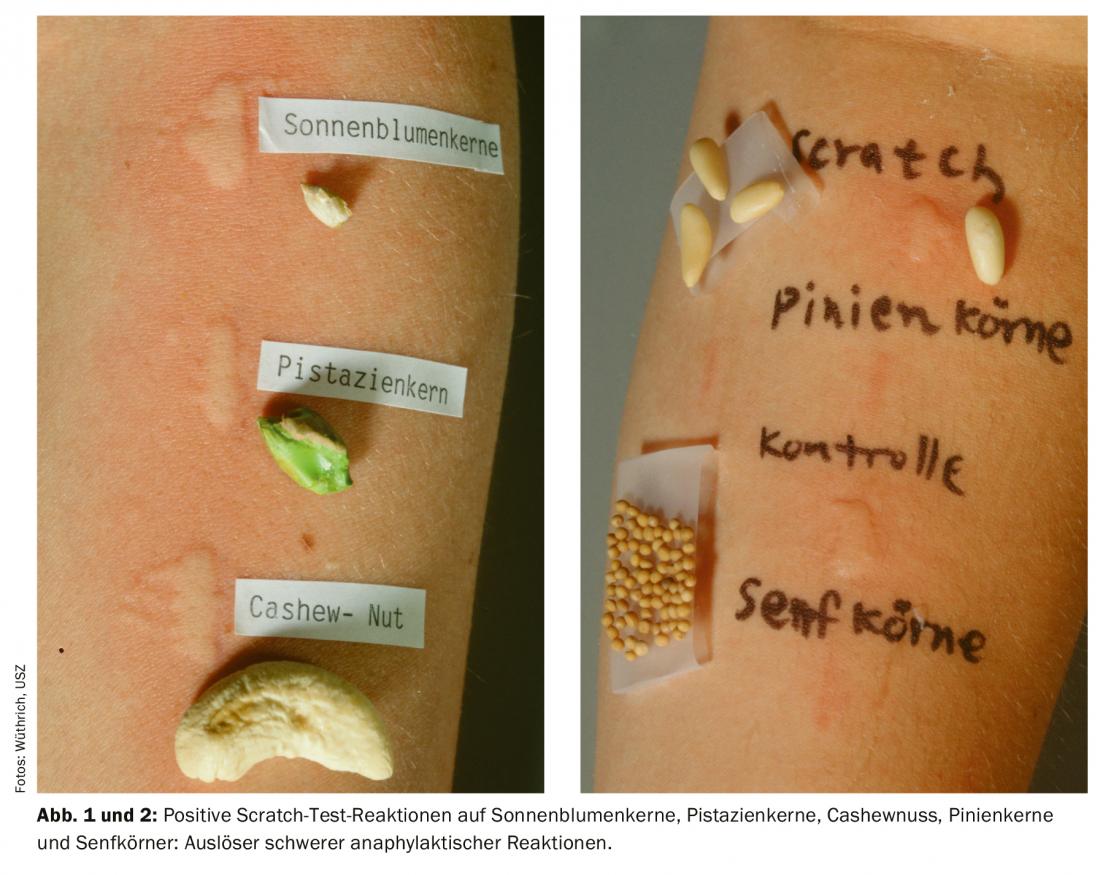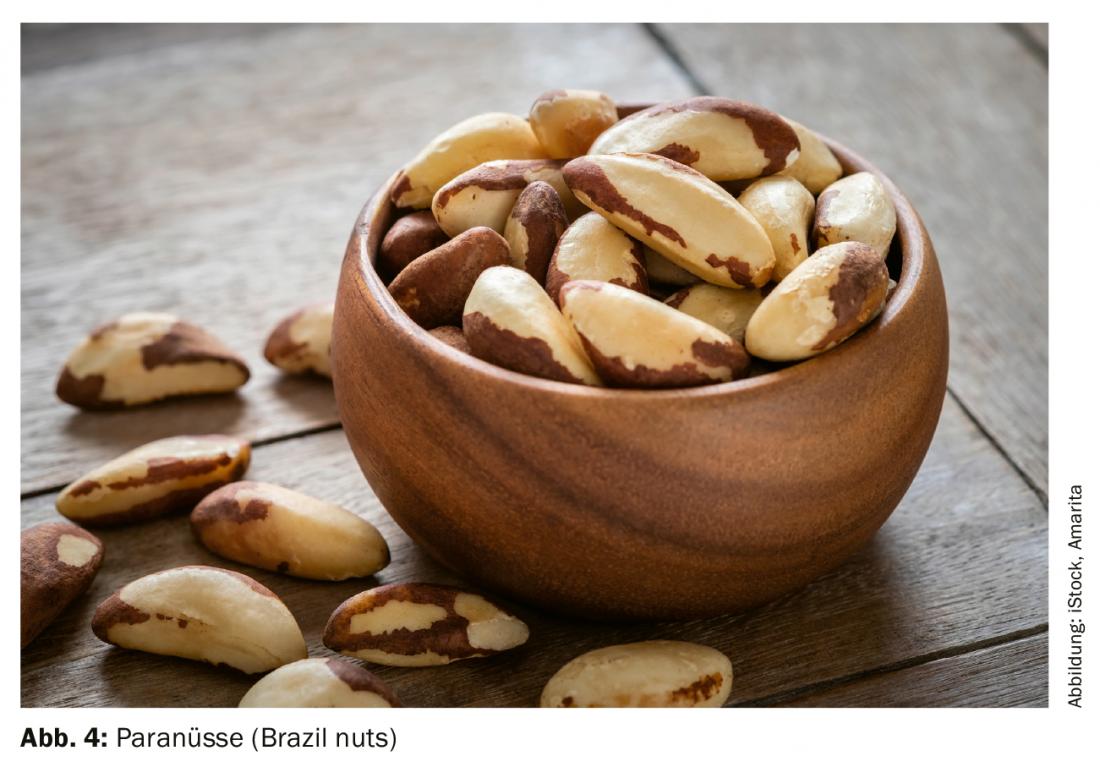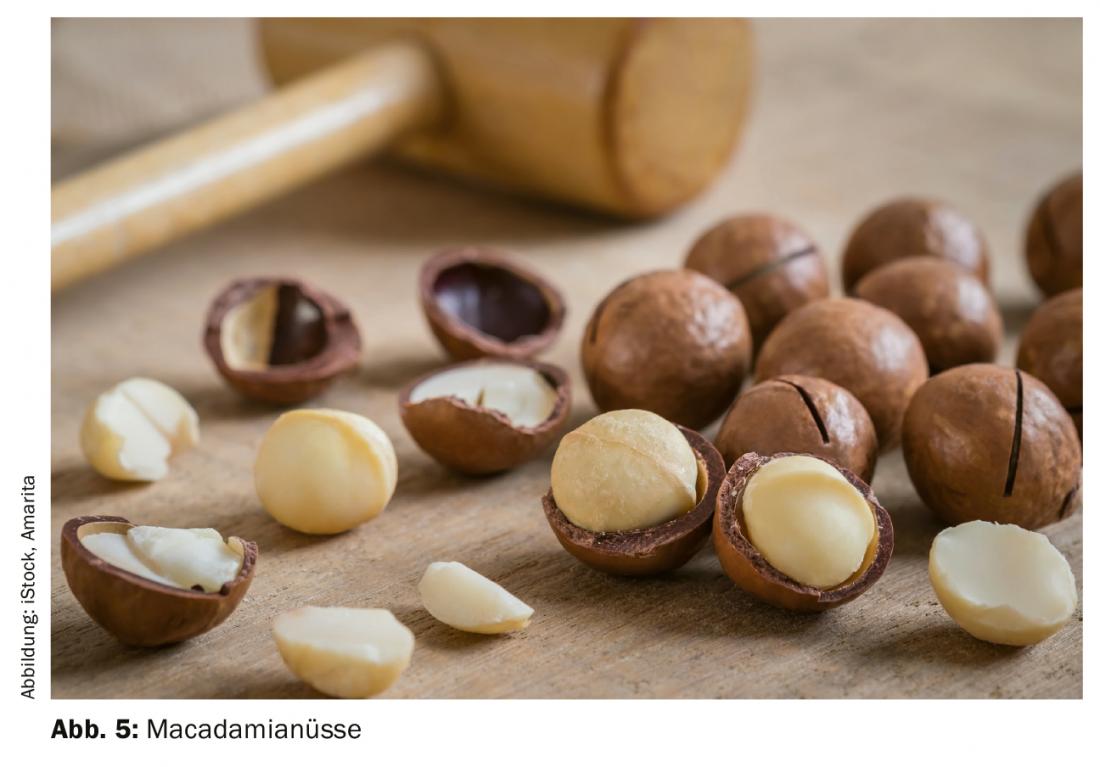“Nuts,” “seeds,” and “kernels” cause more severe than average anaphylactic reactions, some of which are pollen-associated. The allergen trigger can be identified by history, prick-to-prick test and determination of IgE antibodies. It is extremely tricky in the case of genetically modified soybeans, into which the particularly methionine-rich 2S albumin from Brazil nuts has been transferred. For Brazil nut allergy sufferers, the allergen Ber e 1 contained therein poses a high risk.
“Nuts”, “seeds” and “kernels” trigger above-average severe anaphylactic reactions, partly pollen-associated (Fig. 1 and 2) . However, not everything that is called nuts are nuts in the exact sense. Hazelnuts, walnuts, macadamia nuts or even the chestnut (Marone) are rightly called so. Botanically, they are nut fruits in which the seed is enclosed in a woody shell. Nuts fall from the tree in their shells, which is why nuts are also considered to be closing fruits [1].
The peanut, on the other hand, is a legume and therefore related to peas and beans. Pistachios and pecans are stone fruits and therefore in a group with peaches, plums or olives. Characteristically, only the inner pericarp is woody. So eaten is not the seed, but the core. The Brazil nut belongs neither to the nut nor to the stone fruit, but is a capsule fruit. Here, too, the pulp is woody, inside it is the edible seed. The “nuts” grow in large fruit capsules on the tree. Pine nuts are also often counted as nuts after the hard shell is removed.

Table 1, from a previous work with Professors Dr.med. Gabriela Senti and Barbara Ballmer-Weber, MD [2], provides an overview of the botanical and morphological affiliation, of the “nuts”, “seeds” and “kernels”. Previous articles in the “Memoirs of an Allergist” series in this journal have described allergic reactions to sesame seeds [3] and pine nuts [4] in detail. Now follow more reports of allergic reactions to nuts, seeds or kernels.
Case study 1
The 29-year-old female patient (Y.H.) with seasonal rhinoconjunctivitis suffered an allergic attack with cough, rhinitis, epiphora, earache, severe dyspnea, and generalized urticaria two hours after consuming a poppy seed bun (Fig. 3), along with a coffee with liquor. Emergency treatment and referral for allergy workup. This showed positive reactions to grass, hazel, ash, and mugwort pollen in the prick test and positive reactions to poppy and sesame seeds in the prick-to-prick test. Serologically, sensitization to both poppy seeds (CAP class 6, >100 KU/l) and sesame seeds (CAP class 4, 36 kU/l) was confirmed. Thus, a diagnosis of anaphylactic reaction to poppy seeds with possible cross-sensitization between poppy and sesame seeds was made in a female pollen allergic patient.
Case study 2
The 34-year-old patient (M.L.), an American visiting physician, suffered a severe anaphylactic reaction on the occasion of a party with massive Quincke’s edema of the lips, cheeks, and tongue, redness and itching on the soles of the palms and feet, tachycardia, diarrhea. Subsequently, laryngeal edema also occurred. The patient immediately took an antihistamine tablet by os as self-medication at the first symptoms. Since the party took place in the university hospital, he could be treated immediately in the emergency ward with adrenaline i.m. and with a high-dose corticosteroid i.v..
The medical history revealed that he suffered from rhinitis allergica to ragweed (ragweed) and mold spores at the age of 15 years in the USA, for which subcutaneous desensitization was performed over a period of three years. During the cocktail party he took Edam cheese and various nuts (walnut, peanut, hazelnut, almond and Brazil nut) and as a drink a Schweppes tonic (containing quinine) with vodka. In a first phase of allergological clarification, sensitization to ragweed and to the fungal spores Alternaria and Stemphylium was confirmed.
In view of the severe reaction, in vitro determination of specific IgE to walnut, peanut, hazelnut, almond, Brazil nut, and casein was initially performed on the suspected foods, with consistently negative RAST results. Prick and intracutaneous tests with food extracts of cheese, walnut, peanut, hazelnut, and almond were negative (Brazil nut extract was not available), so prick-to-prick tests with Edam, quinine water (Schwepps), and with the various nuts were carefully performed in another session. Only the test with Brazil nut was clearly positive. Thus, the diagnosis of anaphylactic reaction to Brazil nut (with negative RAST test) and status post rhinoconjunctivitis allergica to ragweed and fungal spores could be made.
Case study 3
The 11-year-old boy (U. Sch.) had consumed a macadamia nut at an aperitif hosted by his parents; after 15 minutes, facial erythema and quicke edema of the lips appeared. Prick-to-prick testing with macadamia nut was positive.
Comment
Poppy seeds (Papaver somniferum): The case example 1 is taken from a publication on three cases of the Allergy Station Zurich [5]. The opium poppy allows a dual use. Lactic juice is extracted from the still immature capsule for the production of opium [9]. The ripe ovaries contain seeds that yield a light yellow oil. Poppy seeds are also popular and used in many bakeries, for example, as decoration and flavoring of specialty breads and rolls [5]. Poppy seed cake as a Hungarian specialty is also becoming increasingly popular. Allergic reactions to poppy seeds appear to be quite rare, but may be associated with high-grade sensitization in isolated cases [6]. Not infrequently, they are combined with other food allergies (sesame, hazelnut, buckwheat) [7]. One publication reported work-related bronchial asthma in 6 workers at a pharmaceutical plant processing opium poppies [8].
The allergen is quite thermostable, at least it survives the usual baking processes. It does not seem to be present in the oil. Molecular biology studies were able to detect cross-reactivity between hazelnut, rye seed, poppy seed, sesame seed, and kiwi despite great botanical heterogeneity [9]. Serological analysis of poppy seed extracts revealed responsible glycoprotein allergens (epitopes) with molecular weights of 40- and 45-kD, as well as cross-reactive homologs of pollen allergens, incl. Betv1 and Profiline [10]. The following allergens could be characterized: Pap s 17 kD, a Group 1 Fagales-related protein, a Bet v 1 homologue, a Pap s 34 kD, and a Pap s profilin [10, 11].
For the diagnosis, in addition to the prick test with the native poppy seed, the IgE determination in the CAP test (f224, ThermoFisher) has proven itself in practice [11].
Brazil nut: Brazil nut is also known as Amazon almond, Brazil nut, Juvia or Tucanut or Brazilian chestnut [2]. The fruit of a Brazil nut tree resembles a coconut and consists of a very hard stone shell about 5 mm thick. It measures up to 30 cm in diameter and can reach a weight of up to 3 kg. It contains 25 – 40 hard-shelled nuts or seeds in a concentric arrangement [2] (Fig. 4) . Brazil nuts can trigger local reactions, such as oral allergy syndrome (OAS), when consumed, but can also lead to systemic and skin reactions [12]. Severe anaphylactic reactions in children and adults, which can also be fatal, are described in the literature [12]. According to a study of a Danish patient population, it is calculated that of pollen-sensitized adults with suspected secondary food allergy, approximately 7% suffer from an allergy to Brazil nuts. Of 383 food allergy sufferers from Switzerland, 5.5% had Brazil nut allergy, while 36.8% were diagnosed with hazelnut allergy [13]. In the USA, Brazil nuts are consumed more frequently than in Europe and therefore Brazil nuts rank fifth among nuts among allergy sufferers there [14]. Brazil nut (Brazil nut) is the second highest cause of nut allergies in the UK. USA authors describe a case of a 20-year-old woman with an allergy to Brazil nuts who developed generalized urticaria with respiratory distress following intercourse with her boyfriend, who had previously eaten Brazil nuts. A prick test with semen fluid after the boyfriend ate Brazil Nuts was strongly positive; semen before eating the nuts, however, was negative. The authors postulate that “this is to be the first case of a sexually transmitted allergic reaction” to a nut [15].

The known allergen is the 13 kDa 2S albumin Ber e 1, a storage protein. It is composed of two subunits of 9 kDa and 4 kDa covalently linked by disulfide bridges (according to [12]). Ber e 1 exhibits exceptionally high resistance to proteolytic digestion as well as to thermal and chemical denaturation (according to [12]).). Ber e 1 is believed to be protease resistant due to a very stable globular structure and therefore reaches the intestine in an intact form. However, even peptides formed by digestion are immunogenic because the peptides remain together in a larger fragment of 5 kDa and have been shown to contain intact B- and T-cell epitopes [16]. The Ber e 1 allergen is of particular clinical importance: Of Italian patients with IgE-dependent sensitization to Brazil nuts, only those who were sensitized to Ber e 1 had clinical symptoms when eating Brazil nuts. All asymptomatic subjects had IgE antibodies to Brazil nut proteins ranging from 4 kDa to 58 kDa but not to Ber e 1 [17]. Ber e 1 was thus not only a major allergen with a sensitization rate of 100% in this patient collective, but also the only marker for severe anaphylactic reactions when Brazil nuts were eaten. Because 2S albumin from Brazil nuts is a particularly methionine-rich protein, it was genetically transferred into soybeans to increase its nutritional value. As a consequence, the genetically modified soybeans carried the allergen Ber e 1 and posed a high risk to Brazil nut allergy sufferers [18]. The transgenic soybeans were never marketed because of these findings.
Brazil nuts show cross-reactions with other nuts (walnuts, pecans, hazelnuts cashews, pistachios), with almonds and peanuts, and with pollen of lollipop grass (Lolium perenne) (according to [12]). A combination of history, prick-to-prick test and determination of IgE antibodies to Brazil nut (CAP f18) and to the main allergen (CAP f354 rBer e 1) in serum is suitable for the diagnosis of Brazil nut allergy.
Macadamia nuts (Macadamia tetraphylla, Macadamia integrifolia): Macadamia nuts, also named Australian hazelnuts, are a drupe. They are also called the queen of nuts. The seeds are eaten raw, roasted or salted. Macadamia nuts can cause severe allergic reactions [19]. Also, one case of allergic reaction to cold-pressed macadamia oil was described [20] (Fig. 5).

Click here to go directly to the 2nd part with more case studies.
Literature:
- VERBRAUCHER INITIATIVE e.V. (Federal Association): www.oeko-fair.de/clever-konsumieren/essen-trinken/nuesse/was-sind-nuesse/was-sind-nuesse, last accessed 28.07.2020.
- Senti G, Ballmer-Weber B-K, Wüthrich B: Nuts, seeds and kernels from an allergological point of view. Schweiz Med Wochenschr 2000; 130: 1795-1804.
- Wüthrich B: Memoirs of an allergist: Anaphylaxis after eating a falafel burger – What’s in it? Dermatology Practice 2019; 29 (2): 7-10.
- Wüthrich B: Memoirs of an allergist: Spaghetti al pesto not only releases happiness hormones. Dermatology Practice 2019; 29(3): 8-11.
- Gloor M, Kägi M, Wüthrich B: Poppy seed anaphylaxis. Schweiz Med Wochenschr 1995; 125: 1434-1437.
- Jäger L, Vieths S: Food allergens. 8.11.4. Poppy seed (Papaver somniferum). In: Jäger L, Wüthrich B, Ballmer-Weber B, Vieths S. (Eds.). Food allergies and intolerances. Immunology – Diagnostics – Therapy – Prophylaxis. 3rd ed. Elsevier GmbH, Munich, Urban & Fischer 2008. S. 186.
- Frantzen B, Bröcker EB, Trautmann A: Immediate-type allergy caused by poppy seed allergy 2000; 55(1): 97-98. doi: 10.1034/j.1398-9995.2000.00456.x
- Moneo I, Alday E, Ramos C, Curiel G: Occupational asthma caused by Papaver somniferum. Allergol Immunpathol 1993; 21: 145-148.
- Vocks F, et al: Common allergenic structures in hazelnut, rye grains, sesame seeds, kiwi and poppy seeds. Allergy 1993; 48: 168-172.
- Jensen-Jarolim E, et al: Serological characterization of allergens in poppy seeds. Clinical and Experimental Allergy 1999; 29(8): 1075-1079.
- 2020 Thermo Fisher Scientific Inc, www.phadia.com/en/Products/Allergy-testing-products/ImmunoCAP-Allergen-Information/Food-of-Plant-Origin/Seeds–Nuts/Poppy-seed-/, last accessed 07/28/2020.
- Jäger L, Vieths S: Food allergens. 8.10.4 Brazil nut (Bertholletia excelsa). In: Jäger L, Wüthrich B, Ballmer-Weber B, Vieths S. (Eds.). Food allergies and intolerances. Immunology – Diagnostics – Therapy – Prophylaxis. 3rd ed. Elsevier GmbH, Munich, Urban & Fischer 2008, pp. 180-181.
- Etesamifar M, Wüthrich B: IgE-mediated food allergy in 383 patients considering the oral allergy syndrome. Allergology 1988; 21: 451-457.
- Sicherer SH, Furlong TJ, De Simone J, Sampson HA: Self-reported allergic reactions to peanut on commercial airliners. J Allergy Clin Immunol 1999; 104: 186-189.
- Bansal A, et al: Dangerous Liaison: Sexually transmitted allergic reaction to Brazil nuts. J Investig Allergy Clin Immunol 2007; 17: 189-191.
- Moreno FJ, et al: Stability of the major allergen Brazil nut 25 albumin (Ber e 1) to physiologically relevant in vitro gastrointestinal digestion. FASEB J 2005; 272: 341-352.
- Pastorello EA, et al: Sensitization to the major allergen of Brazil nut is correlated with the clinical expression of allergy. J. Allergy Clin Immunol 1998; 102: 1021-1027.
- Nordlee JA, et al: Identification of Brazil-nut allergen intransgenic soy beans. N Engl J Med 1996; 334: 688-692.
- Häberle M, Hausen BM: Allergic reactions to macadamia, the queen of nuts. Allergology 2006; 29: 103-108.
- Teuber SS, Brown RL, Haapanen LA: Allergenicity of gourmet nut oil processed by different methods. J Allergy Clin Immunol 1997; 99: 502-507.
DERMATOLOGY PRACTICE 2020; 30(4): 45-48













